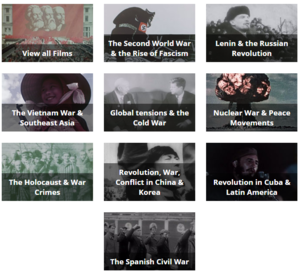
The Socialism on Film subcollections offer a curated view of important moments in the history of socialism.
Socialism on Film (SOF) is a remarkable project, detailing the history of the most important political, philosophical, and economic movement of the last one hundred and fifty years, and its reflection on the cinema. An undertaking quite clearly years in the making, it has collected films of all kinds from nations around the globe, courtesy of the archive of the British Film Institute (BFI), from the dawn of the motion picture to the dissolution of the Soviet Union, and uploaded them to the SOF database, where subscribers can view them at their leisure. The site is owned and managed by Adam Matthew Digital, in partnership with the BFI. It offers short free trials, and federated access through OpenAthens, The UK Access Management Federation, and the Deutsches Forschungsnetz Network. It is mainly targeted at educators, for obvious reasons. I was provided with trial access to SOF, which gave me full access to the site for about a month.
SOF is equally a venture in historical study as it is in film study. It offers detailed directories for targeted searches, as well as visual guides and maps. As a reference, it hosts a timeline, in a tab called “Chronology.” This timeline is viewed in a pop-out browser window and shows important events in the history of socialism, from the birth of Karl Marx in May 1818, to the emancipation of the Soviet Bloc states in December 1991. It does not include the release of the various films in the catalog, but the timeline should be viewed alongside them as a primer on the background of the history of socialism.

The Chronology window is a useful resource for understanding the background to the films in the collection.
The films are indexed by directory and subcollection. Examples of directories include the subject material, country of production, directors, cast, genre, contributors, production companies, and language of the films. Language is a detailed category that distinguishes between dialogue, narration, and interview. The directories of historical figures featured in the films encompass such as figures Konrad Adenauer and Tsar Nicholas II, and place. Place is different from country of production, in that it includes localities, for example Antarctica, or the Yangtze River. Users can combine selections from each of these directories to refine a search down to minute proportions.
The subcollections are organized around more broad strokes in socialism history. These are, in order: “The Second World War and the Rise of Fascism,” “Lenin and the Russian Revolution,” “The Vietnam War and Southeast Asia,” “Global Tensions and the Cold War,” “Nuclear War and Peace Movements,” “The Holocaust and War Crimes,” “War and Conflict in China and Korea,” “Revolution in Cuba and Latin America,” and “The Spanish Civil War.” A third way to explore the collection is offered with an interactive world map. The map places bubbles on the countries of the world, the size of the bubble corresponding to the quantity of films made in that country. As one might imagine, Russia has the largest bubble by far. When users zoom in on the map, the bubbles shift from the countries, to the cities and other noteworthy locations that films were set in. This is a good, simple way to explore the collection in a highly visual way, and a more entertaining one than simply sifting through directories for hours.
In addition to films, SOF has collected some other media. In cooperation with leading academics, SOF brings video interviews, essays, and case studies to the table. These provide valuable background to the films and to the history of socialism, which, as mentioned before, is certainly the most important ideology of the 20th century, and is worth examining, even though it has, for the most part, been replaced by other systems. These sections are, for now at least, relatively quite small, offering no more than twenty pieces combined, but as an information delivery system are quite valuable. The case studies in particular are a great addition. Short videos made with academics, they focus on East Germany, the USSR, and North Vietnam. Unfortunately, there are only four of them, but they accomplish their purpose well. They are designed to be watched before viewing the film that they are associated with; this will deepen the understanding and appreciation of the film.
As a resource for educators, SOF is not offered on Roku, mobile devices, or other platforms. The only way to view the resources is on a laptop or desktop, which is fine for a service that is not intended for casual consumers. The trials are open to teachers, faculty, and librarians of academic institutions of all levels, but not to undergraduate students; undergrads are advised to contact faculty or librarians to register for trials on their behalf. This service could be invaluable to both film and history educators, and it provides a solid foundation for the emerging field of film history. While it’s not possible to recommend it to the regular consumer, due to the nature of the product, I can definitely recommend it to anyone who may be teaching about the Cold War or the history of socialism, or even a course on documentary films.
Author Biography
Emmett Williams is a senior, double majoring in film studies and history. His interests mainly include exploring the intersection of film and history, as well as examining political history.








































